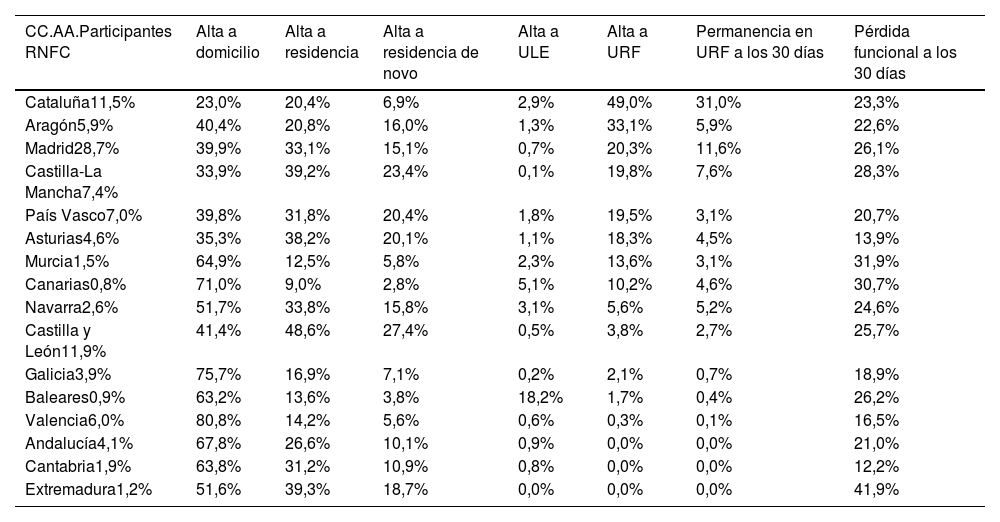El Registro Nacional de Fracturas de Cadera (RNFC) facilita el conocimiento del proceso de la fractura de cadera en España tanto para los clínicos como para los gestores y favorece la reducción de la variabilidad de los resultados encontrados incluyendo el destino al alta tras la fractura de cadera.
ObjetivoDescribir la utilización de Unidades de Recuperación Funcional (URF) por parte de los pacientes con fractura de cadera incluidos en el RNFC y comparar los resultados entre las diferentes comunidades autónomas (CC.AA.).
Material y métodosSe trata de un estudio observacional, prospectivo y multicéntrico de varios hospitales de España. Se analizaron los datos de una cohorte del RNFC de pacientes ingresados con fractura de cadera entre 2017 y 2022, centrándose en la ubicación al alta de los pacientes, en concreto en el traslado a URF.
ResultadosDe una muestra de 52.215 pacientes procedentes de 105 hospitales, 9540 pacientes (18,1%) se trasladaron a URF al alta y 4595 (8,8%) permanecían en estas unidades 30 días después, con una distribución variable entre las distintas CC.AA. (0-49%) y con resultados variables en deterioro funcional a los 30 días (12,2-41,9%).
ConclusionesEn el paciente ortogeriátrico existe una disponibilidad y utilización desigual de las URF entre las distintas CC.AA. El estudio de la utilidad de este recurso puede ser de gran valor para la toma de decisiones en políticas de salud.
The National Registry of Hip Fractures (RNFC) facilitates knowledge of hip fracture process in Spain to clinicians and managers and is useful to the reduction of the results variability, including the destination at discharge after the hip fracture.
ObjectiveThe aim of this study was to describe functional recovery units (URFs) use for patients with hip fracture included in the RNFC and to compare the results of the different autonomous communities (AC).
Material and methodsAn observational, prospective and multicenter study of several hospitals in Spain. Data from a RNFC cohort of patients admitted with hip fracture between 2017 and 2022 were analyzed, focusing on the location at discharge of the patients, specifically on transfer to the URF.
Results52,215 patients from 105 hospitals were analyzed, 9540 patients (18.1%) were transferred to URF upon discharge and 4595 (8.8%) remained in these units 30 days later, with a variable distribution between the different AC (0–49%) and variability of results in patients not recovering ambulation at 30 days (12.2–41.9%).
ConclusionsThere is in orthogeriatric patient an unequal availability and use of URFs between different autonomous communities. The study of the usefulness of this resource can be of great value for decision-making in health policies.









